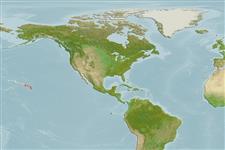Actinopterygii (peixes com raios nas barbatanas) >
Perciformes (Perch-likes) >
Callionymidae (Dragonets)
Etymology: Synchiropus: Greek, syn, symphysis = grown together + Greek, cheir = hand + Greek, pous = foot (Ref. 45335); rosulentus: Named in reference to the series of pink roselike blotches along the side of the body.. More on author: Randall.
Ambiente / Clima / Intervalo
Ecologia
; marinhas associadas(os) a recifes; intervalo de profundidade 5 - 24 m (Ref. 33412). Tropical, preferred ?
Distribuição
Países | Áreas FAO | Ecossistemas | Ocorrências | Point map | Introduções | Faunafri
Eastern Central Pacific: Hawaiian Islands and Johnston Island.
Tamanho / Peso / Idade
Maturity: Lm ? range ? - ? cm
Max length : 2.2 cm SL macho/indeterminado; (Ref. 33412)
Descrição suscinta
Morfologia | Morfometria
Espinhos dorsais (total): 4; Raios dorsais (total): 9; Espinhos anais 0; Raios anais : 8. Males with 5 irregular brown blotches dorsally on body and a row of seven orange pink blotches along side linked dorsally by a midlateral narrow orange pink stripe; two small jet black spots above base of each pelvic fin; broken blue lines (brown in preservative) on head below eye, continuing onto gill membranes and pectoral-fin base where alternating with yellow; first dorsal fin with long dusky yellow to orange pink streaks on membranes; females similar but lacking the two small black spots and the blue and yellow striping of the lower head and pectoral-fin base; posterior two-thirds of the short first dorsal fin black.
Collected from sand and rubble bottoms adjacent to coral reefs or rocky areas (Ref. 33412). Benthic (Ref. 58302).
Life cycle and mating behavior
Maturidade | Reprodução | Desova | Ovos | Fecundidade | Larvas
Randall, J.E., 1999. Review of the dragonets (Pisces: Callionymidae) of the Hawaiian Islands, with descriptions of two new species. Pac. Sci. 53(2):185-207. (Ref. 33412)
Status na Lista Vermelha da IUCN (Ref. 115185)
CITES (Ref. 94142)
Not Evaluated
Perigo para os humanos
Harmless
Uso pelos humanos
Mais informação
PaísesÁreas FAOEcossistemasOcorrênciasIntroduçõesStocksEcologiaDietaItens alimentaresConsumo alimentarRação
Nomes comunsSinônimosMetabolismoPredadoresEcotoxicologiaReproduçãoMaturidadeDesovaFecundidadeOvosDesenvolvimento dos ovos
Idade/TamanhoCrescimentoComprimento-pesoComprimento-comprimentoFrequências de comprimentoMorfometriaMorfologiaLarvasDinâmica larvalRecrutamentoAbundância
ReferênciasAquaculturaPerfil para aquaculturaEstirpesGenéticaFrequência alélicaHereditariedadeDoençasProcessamentoMass conversion
ColaboradoresFotosStamps, CoinsSonsCiguateraVelocidadeTipo de nataçãoÁrea branquialOtólitosCérebrosVisão
Ferramentas
Relatórios especiais
Baixar XML
Fontes da internet
Estimates of some properties based on models
Phylogenetic diversity index (Ref.
82805): PD
50 = 0.5000 [Uniqueness, from 0.5 = low to 2.0 = high].
Bayesian length-weight: a=0.01047 (0.00408 - 0.02689), b=2.96 (2.74 - 3.18), in cm Total Length, based on LWR estimates for this (Sub)family-body shape (Ref.
93245).
Nível Trófico (Ref.
69278): 3.1 ±0.3 se; Based on size and trophs of closest relatives
Resiliência (Ref.
69278): Elevada, tempo mínimo de duplicação da população menor que 15 meses (Preliminary K or Fecundity.).
Vulnerabilidade (Ref.
59153): Low vulnerability (10 of 100) .
